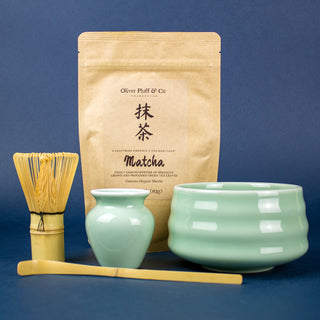Dear Oliver,
I am sending a bit more info on the specifics of matcha for your readers. According to
Britannica, “Combining the Japanese words matsu, “to rub, to daub, to paint” and cha, “tea,” matcha is grown according to strict rules. Matcha must be taken from shade-grown tea plants, which have heightened levels of chlorophyll and have a bright green colour. Only the buds and top three layers of the young tea plant, Camellia sinensis, are harvested. The tea leaves are steamed to halt the oxidation process, then deveined and ground in stone mills.”
For anyone who has seen ceremonial matcha, it certainly is a vivid green color – retaining the hue of budding leaves. And, the umami flavor, which is often described as a pleasing, savory taste, can be quite intense. Although frothing with a bamboo whisk is the traditional method for serving the tea, that is simply the preferred preparation, not essential for drinking.
 .
. 
Matcha generally comes in large or single-use packets or canisters of tea powder, which is mixed directly with water. This powder is then consumed and not discarded like traditional green tea leaves. In Japan, I noticed, that packets of ground green tea, both traditional and roasted, were readily available in most places such as hotel rooms and restaurants.
The growing process and preparation increase the level of caffeine per serving, so that is worth noting for people who are sensitive. From the matchalibrary there are two main types of matcha for purchase, “Ceremonial Grade: The pinnacle of quality, ceremonial grade is intended for traditional tea ceremonies. It boasts a vibrant green color, a fine texture, and a delicate sweetness with minimal bitterness.
This grade is best enjoyed whisked with hot water alone, allowing its refined flavor to shine. Culinary Grade: More robust than its ceremonial counterpart, culinary grade is designed for cooking and baking. It has a stronger flavor and is ideal for recipes like lattes, smoothies, and desserts. While its color may be slightly less vibrant, it packs a punch in terms of taste and is more affordable, making it a versatile option for everyday use.”
Smoothies are a great way to literally blend matcha into your daily routine. It seems most smoothie recipes for matcha start with a milk or milk alternative product followed by banana and possibly other fruit such as pineapple. Then, if you want to really go for the green, spinach can be added as well as avocado. Really, regarding smoothies, the options are endless, but it seems some flavors truly pair the best.
Yogurt is a common ingredient as well as honey or maple syrup for sweetness.
Health.Harvard claims, “Matcha contains an abundance of antioxidants (including polyphenols such as catechins) and phytochemicals (such as chlorophyll and quercetin). These substances may have some positive effects on our health, particularly when they are consumed in foods that naturally contain them.”
Look for the healthy Matcha wherever you purchase your favorite Oliver Pluff & Co. tea.



